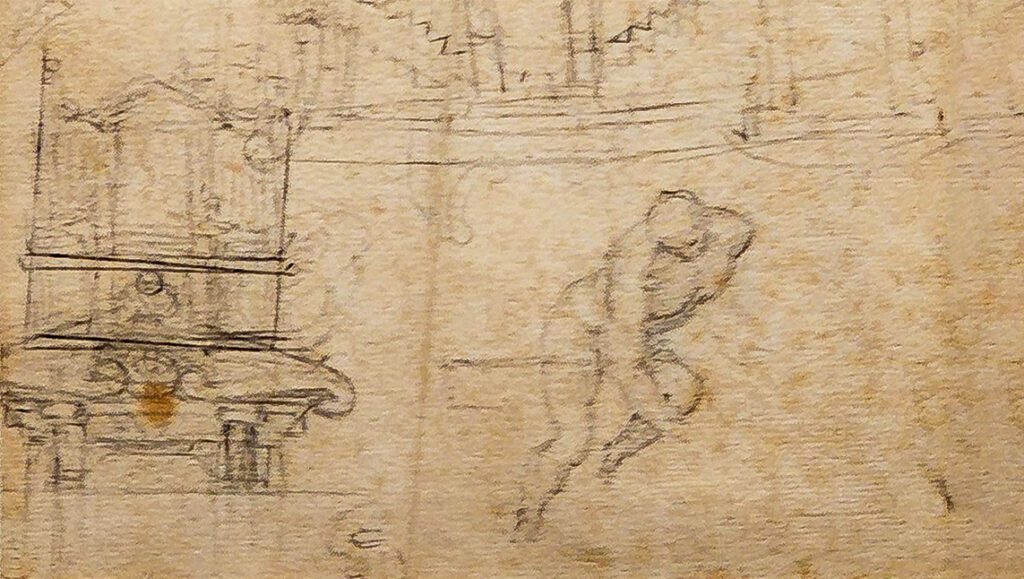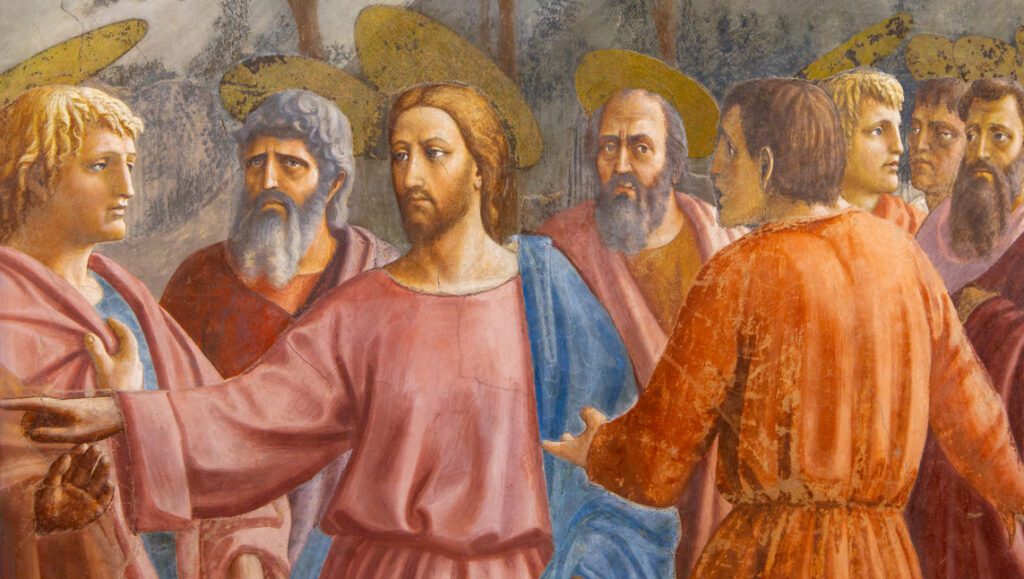
A exhibition dedicated to a very unknown artist
The exhibition dedicated to Ambrogio Lorenzetti, was held in 2017. There could be no greater need to shed light, through an updated scientific work, on a great protagonist of Italian painting of the fourteenth century such as this painter, an artist whose name is slavishly linked to the famous Buon Governo frescoes in Siena but of which so far, there has been no research work to shed light on his career.
The stereotypical Lorenzetti’s reputation as a civic painter due to the frescoes in Palazzo Pubblico has long eclipsed a multi-faceted and eclectic nature. Thanks to an exhibition – the first monographic ever dedicated to him – clarity is made about the activity of Lorenzetti and given a new stylistic interpretation of the Sienese painter.
The exhibition dedicated to Ambrogio Lorenzetti was held in the Santa Maria della Scala Museum of Siena. In the rooms of the old hospital, the 31 works by Lorenzetti had come up with targeted loan requests – sometimes coming from prestigious institutions such as the Louvre of Paris and the National Gallery of London – which have had the specific purpose of bringing together again on those paintings that were commissioned in large part precisely for this territory.
The exhibition was curated by Alessandro Bagnoli and Roberto Bartalini, professors of the University of Siena, and by Max Seidel as well, emeritus director of the Kunsthistorisches Institut of Florence. The catalog drawn up by the curators also serves as the first modern monograph on the artist as it is not limited to talking about the works on display but is concerned with framing the entire Ambrogio’s artistic parable, all in the historical context in which he found himself operating. Supported by preventive archival research and restoration campaigns on some works, the exhibition and catalog deal with and largely solve the problems that until now made the dating of some paintings uncertain.

Miracle of the granary ships, A.Lorenzetti, 1332 ca, Uffizi Gallery
The exhibition itinerary begins by focusing on the artist’s apprenticeship – which is why in the first room of the exhibition there are no paintings by Ambrogio rather by the artists who influenced his education – in a crucial period such as the second decade of the 1300s , full of incitement and experiences, when next to Simone Martini who in 1315 signed the Maestà in Palazzo Pubblico – his first known work – the Sienese scenery was dominated by Duccio di Buoninsegna’s workshop, receiving assignments both from civil and ecclesiastical institutions.

Annunciation, A.Lorenzetti, 1336 c, Montesiepi Hermitage, Chiusdino
While of the Duccio’s Maestà painted for Massa Marittima Cathedral (Cat.1b) – his last documented work – is exhibited the back side, – the panel representing Christ blessing is by Simone Martini and it comes from the Vatican Museums (Cat.2). Is this a work appropriately inserted in the exhibition because the frontal view of Christ bears witness how much Ambrogio drew inspiration from the Martini’s painting for some of his compositions, as is already evident in the Madonna di Vico l’Abate by Lorenzetti (Cat.6), dating back almost at the same time as the Vatican panel.

Maestà, Lorenzetti, 1340 ca, Museo San Pietro all’Orto, Massa Marittima
In this work, the first documented by the young Ambrogio (1319), is where in fact some cogent correspondences with the painting of Simone Martini emerge both for the style (the monumentality of the Virgin is actually closer to the princely figure of the Capodimonte’s Saint Louis of Toulouse than not to the marmoreal coldness of Arnolfo di Cambio) and, above all, for that way of thinking to the painted tables as a jewellery piece.
Goldsmiths’ hallmark
It’s already from this work that the wish of Ambrogio to embellish the painting with threads of gold and depictions of jewels – as well as refined chromatic variations, no longer visible on the table – also making use, starting from the subsequent works, of the “Punzone” (punching technique) that was typical of goldsmiths and that was a Simone Martini’s hallmark.
The first room is completed by two important paintings by Pietro, the older brother of Ambrogio to whom the formation of the young Lorenzetti is to be ascribed, unlike what was previously claimed.

Madonna di Vico l’Abate,1319, A.Lorenzetti, San Casciano Val di Pesa Museum
In fact, the two brothers found themselves working side by side on several occasions, such as in the lost frescoes for the Santa Maria della Scala’s façade – together with Simone Martini – and in the Church of San Niccolò al Carmine as well, where while Pietro signed the polyptych for the high altar, Ambrogio realised the beautiful, albeit ruined, painted cross for the ancient partition of the church (cat.10).
In the show dedicated to Ambrogio Lorenzetti, a famous but unknown artist, also we have the San Nicola’s stories (Catt. 13a-be 13c-d) – coming from the Uffizi Gallery – and a small panel from Frankfurt (Cat.14). In these small seized works is where the most original and misunderstood figure of Ambrogio emerges, which is that of a painter intent on experimenting with a ‛naturalistic’ investigation whose results in some cases are truly spectacular as well as surprising, especially taking into account that the tablets with stories, which are part of a painted polyptych for the Florentine church of San Procolo, date back to the third decade of the fourteenth century, a date that is in some ways precocious in terms of achievements in the “investigation of the natural”.

Madonna del latte, A.Lorenzetti, 1340 ca, Museo diocesano Siena
Painting “atmospheric phenomena”
Lorenzetti goes even beyond this, since he tries to reproduce atmospheric phenomena. This ability earned him the praise of an exegete and great artist of the ‘400 as Lorenzo Ghiberti; finding himself in Siena on several occasions, the Florentine celebrated Ambrogio’s painting, evoking in his Commentarii the exaltation that in the antiquity Plinius the Elder had done for the painting of Apelles. Overcoming “all those who lived before and after him” , the Lorenzetti’s art is approached by Ghiberti to that of the famous greek painter of the ancient world for the representation of a storm like Ambrogio created for a cycle of frescoes in the cloister of San Francesco in Siena. Gone almost destroyed, of that hagiographic cycle of which Ghiberti describes the “turbulence of dark weather with much hail trembling thunder trembles” the scene of the storm (Cat. 19a) is miraculously preserved with even a piece of a city (the Indian one of Thana, where the Franciscan missionaries suffered martyrdom).
This natural setting was made not very differently from the representation of Siena that Ambrogio made in the Sala della Pace in Palazzo Pubblico in 1338, two years after the San Francesco’s cycle.
Through the works on display we can appreciate how Lorenzetti investigates the naturalistic component – a thing evident, as we have said, in the Saint Nicholas’ stories or even in a painting in some ways still mysterious like the Allegory of Redemption (Cat.22) – but also how he proposes solutions that renew the traditional modules: it can be particularly appreciated in the scene of the Homage to the Virgin painted in fresco for the chapel of Montesiepi (Cat.15).
The Montesiepi Chapel’s frescos
Recreating the setting of Paradise, in the Montesiepi Chapel Ambrogio realizes an uncanonical program and divides the scene on the three lunettes. Subjected to a conservative restoration carried out in the form of an “open yard”, the Galganian cycle can now be appreciated from a close position thanks to the evocative setting by the renowned Guicciardini & Magni museographic studio which recreated the original location of the frescoes in the chapel in the show dedicated to Ambrogio Lorenzetti.
The displaying of the San Pietro in Castelvecchio’s polyptych (Cat.24a-e and 24f) in the exhibition dedicated to Ambrogio Lorenzetti was preceded by a restoration as well. Coming from the homonymous Sienese church, the tables forming part of the painting, heavily disfigured by unfortunate interventions in ancient times, still denote a very high quality execution, as can be seen in the extraordinary St.Michael’s armour, or in the volume and chiaroscuro rendering of the characters that even seem to portend some plastic effects of the first Renaissance painting.

Reconstruction of the lunettes of the Montesiepi Hermitage, A.Lorenzetti, 1336, Chiusdino
A Renaissance painter?
If we certainly cannot go so far as to number Lorenzetti among the Renaissance artists, in my opinion we cannot overlook the extraordinary results that Ambrogio achieves in this last mentioned work in terms of depth rendering: for example, note how the Virgin’s right arm in the central table it appears as a tubular reflecting light, an effect further emphasised by the use of a palette of ‘pure’ and bright colours, the latest one is the umpteenth Ambrogio’s key feature among his contemporary painters.
If one can often find a continuous search for stylistic and iconographic innovation in his works, the intellectualistic revival of archaic motifs, such as the reference, borrowed from some Duccio’s works, from the Byzantine theme of the Glikophilousa (Greek term that defines the iconography of the “tenderness’ Virgin” cited in the Maestà of Massa Marittima (Cat.17)) or the chrysographs reproduced in the Madonna della Loggia dei Nove (Cat.23). Ambrogio Lorenzetti is therefore an eclectic painter, and analysing the works that are proposed through the exhibition – rightly considered as a “necessary exhibitions” by an eminent scholar like Tomaso Montanari – has restored the greatness of one of the most important personalities of the fourteenth century in the history of art ⟣
Bibliography
A.Bagnoli, R.Bartalini, M.Seidel (a cura di), Ambrogio Lorenzetti, catalogo della mostra, Silvana Editoriale Cinisello Balsamo, 2017 (Italian edition)



